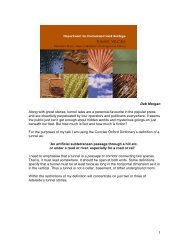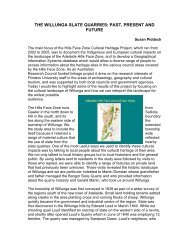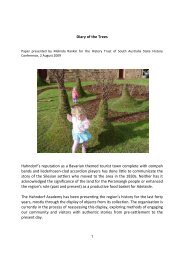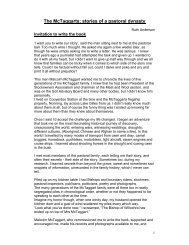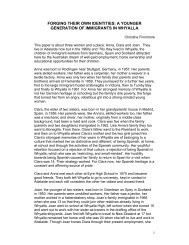Southward Bound Information - History SA
Southward Bound Information - History SA
Southward Bound Information - History SA
You also want an ePaper? Increase the reach of your titles
YUMPU automatically turns print PDFs into web optimized ePapers that Google loves.
were able to deliver a reasonable volume of water for a short period. In serious<br />
cases of fire one of the most successful methods of combating it was, at this time<br />
(and for some years to come), to batten down the holds and plug every opening,<br />
denying the fire air.<br />
STORMS AND WEATHER:<br />
The ship may have lay at anchor for 20 or more days awaiting a good slant of wind<br />
to begin the voyage.<br />
The majority of ships left the northern hemisphere in winter, thereby arriving in<br />
South Australia during winter and giving the migrants time to acclimatise before<br />
summer. Unfortunately, departing at this time of year could mean an<br />
uncomfortable trip.<br />
It is usual, in winter, to encounter a series of gales rolling up the Atlantic Ocean<br />
from the south west. These can cause a ship to bucket about unmercifully for<br />
days, sometimes weeks, on end. This meant the first days at sea for most<br />
migrants, packed into dark, cramped, frequently smelly quarters, were far from<br />
pleasant.<br />
Aboard a sailing ship in heavy weather, it was impossible to keep the below decks<br />
dry. In poorly maintained vessels it veritably rained in the accommodation. Another<br />
source of wetness was the hatchways. It was not uncommon for water ankle deep<br />
to slosh about in the quarters - slushy, slimy water.<br />
During a gale (which could last days) steerage emigrants were battened below.<br />
Secured ‘for their own safety’ steerage passengers struggled to walk, serve meals<br />
and attend to their toilet on heaving, crazily slanting decks. Ignorant of what was<br />
happening above, they could only hope that the continual creaking and groaning of<br />
the ship’s timbers was a sign of mature strength and not weakness which would<br />
give way to swamp them in tons of water.<br />
The sufferings of steerage passengers at such times was almost indescribable.<br />
Many cabin passengers from the relative safety of their airy compartments<br />
complained of ‘the stench issuing from the between deck’ when the hatches were<br />
finally opened.<br />
SHIPWRECK:<br />
Ships could be wrecked for a number of reasons:<br />
a. Fire.<br />
b. Storm - the Roaring 40s and the Howling 50s.<br />
c. Unchartered islands, reefs or sections of the mainland.<br />
d. Icebergs - if the ship travelled too far south.<br />
A ship could be wrecked without people in Britain becoming aware of the loss for 6<br />
months or more - its cause might never be known. A damaged ship might not be<br />
lost; it could be limping out under jury rig (having been dismasted) and would<br />
arrive weeks or months later.



